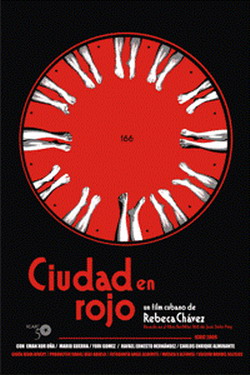Cuban filmmaker Rebeca Chávez and her City in Red
- Submitted by: admin
- Arts and Culture
- Cinema
- culture an traditions
- Entertainment
- Society
- 04 / 13 / 2009

Cuban filmmaker Rebeca Chávez couldn’t have chosen a more recurrent theme in cinema (and therefore challenging) for her feature film debut than violence in its most extreme connotation, the one that goes from life to death with no in-betweens.
Since the days of silent classics –gangster and war films, westerns, etc. - to reflect on violence, its moral implications, the limit between good and evil sometimes diluted in the complexity of political, social or simply human stories, has been an insistence of many directors.
A quick look at the history of cinema allows us to appreciate the support of even well defined aesthetics for the issue, and it would suffice to remember figures like Sergio Leone, Jean Pierre Melville, or the so many times censured by his own producers, Sam Peckinpah.
Hence, Rebeca’s challenge was big when she set out to tackle –once again- the philosophical discernment of the old dilemma of "kill so I’m not killed", especially when the performer belongs to the category of the good guys, protected by an ideal of justice, very different to the cold assassination practiced by the supporters of the Fulgencio Batista dictatorship.
It would seem as if everything had been said in cinema in terms of violence as the moral problem of the involved, but the director returns to the bullring and in somewhat of Costa-Gavras’ style in Stage of Siege (1973), she incorporates the chaotic pulse of a city, Santiago de Cuba of the end of the 1950’s, with the Sierra Maestra rebels and the city breathing the sulfur of gunpowder 24 hours a day.
The tense setting of City in Red is well reconstructed with that symphony of cars coming and going carrying nervous soldiers ready to fire on the young people they are after, and also of scenes that recreate the commitment of a rebellious population or others for which the silence of Santiago nights were filled with fright.
What is known about that atmosphere of terror is thanks to witnesses who still remember with a wealth of detail, and also thanks to literature and documentary cinema which have shown that the conspiracy against the Batista regime, and along with it moving every day between life and death, proved to be, for its constant nature, something as natural as drinking a glass of water (without the classic "rumba" of concerns stopping from making people shudder on the inside).
You’re moved just by thinking about it and several images of the film affect the audience while reconstructing, in a realistic way, the consequences of that struggle. But the epic and the anecdotal end up by imposing the complexity of the matter the producers were dealing with — violence as catharsis and the mental ambiguities of those who find themselves subjected to it— which is pushed to the background and with contributions to the conflict. Or perhaps the film is somewhat schematic in its artistic treatment, or similar to others already seen in dozens of movies developed in different historical contexts.
City in Red allows us to appreciate, generally speaking, a stimulating effort and at times high-flying that makes the public speak about the dedication and effort put into the production of the film. There are sequences where photography, artistic direction, music and acting concrete real states of grace. However they don’t manage to keep a constant pace, but rather show an alternation of qualities in which not very convincing aspects of the script come to surface. Like the trite situations and dialogues among revolutionary youngsters and their parents, among them, and facile visual and dramatic composition here and there, like in the scene in which the girl and her boyfriend disarm a soldier, or the final execution of the henchman, with the scene having an air that seems to have been taken from The Godfather.
These are debatable aspects that to some extent conspire against the whole of a film full of suspense, and perhaps with too many bursts of machine-gun fire and surprising shots in the center of the chest to be able to develop more complex plots around characters, none of them the absolute protagonists of the story, a level that Santiago de Cuba city aspires to and undoubtedly achieves.
Rebeca Chávez comes from the world of documentary and here she makes an excellent use of the resources of the genre linked to fiction to begin and end her film. City in Red is moving, a must-see, both by those who love history and by those who, looking from behind glass windows, forget.
(Granma)
Comments